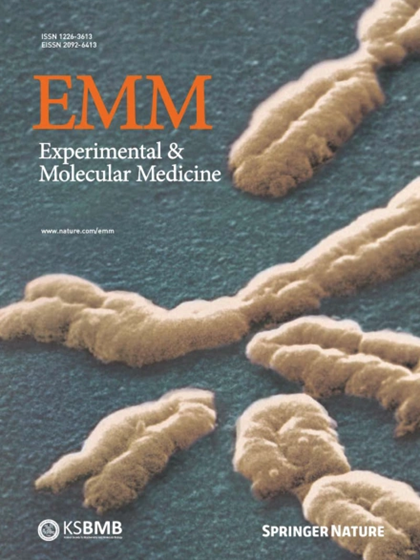CD300E+巨噬细胞促进肝硬化失代偿患者脾切除术后肝脏再生。
IF 9.5
2区 医学
Q1 BIOCHEMISTRY & MOLECULAR BIOLOGY
引用次数: 0
摘要
肝硬化与随后的肝功能衰竭导致的预期寿命差有关。因此,了解肝硬化损伤期间的肝脏再生过程是非常重要的。本研究探讨巨噬细胞异质性在脾切除术后肝再生中的作用。我们收集了54例失代偿性肝硬化患者脾切除术前后的详细临床资料。肝硬化患者脾切除术后肝再生明显。采用单细胞RNA测序(scRNA-seq)方法对患者手术前后的3对肝脏组织进行测序,探讨免疫微环境图谱和肝再生相关巨噬细胞(RAMs)的特征。scRNA-seq分析显示,脾切除术后肝脏免疫细胞组成发生变化;其中,术后CD300E+ RAMs比例显著增加,与细胞增殖相关的功能基因高表达促进了肝脏再生。此外,我们还建立了四氯化碳诱导的肝硬化小鼠模型和由原代骨髓来源的巨噬细胞和肝细胞组成的共培养系统进行验证。我们在肝硬化小鼠中观察到类似的肝脏再生现象,并进一步证实CD300E+单核细胞来源的巨噬细胞通过分泌NAMPT促进肝细胞NAD+合成,从而促进肝细胞增殖。本研究描述了脾切除术后肝硬化患者的肝脏免疫微环境。我们的研究结果表明,CD300E+巨噬细胞在脾切除术后肝脏免疫微环境的重塑中起着至关重要的作用,从而促进失代偿肝硬化患者的肝脏再生。CD300E+巨噬细胞有望成为治疗肝硬化的一种新的治疗策略。本文章由计算机程序翻译,如有差异,请以英文原文为准。

CD300E+ macrophages facilitate liver regeneration after splenectomy in decompensated cirrhotic patients
Liver cirrhosis is prognostically associated with poor life expectancy owing to subsequent liver failure. Thus, understanding liver regeneration processes during cirrhotic injury is highly important. This study explored the role of macrophage heterogeneity in liver regeneration following splenectomy. We collected detailed clinical information from 54 patients with decompensated cirrhosis before and after splenectomy. Obvious liver regeneration was observed after splenectomy in cirrhotic patients. Single-cell RNA sequencing (scRNA-seq) was performed on three paired liver tissues from patients before and after surgery to explore the immune microenvironment map and the characteristics of liver regeneration-associated macrophages (RAMs). scRNA-seq analysis revealed that the composition of hepatic immune cells changed after splenectomy; among these changes, the proportion of CD300E+ RAMs significantly increased after surgery, and high expression levels of functional genes associated with cell proliferation promoted liver regeneration. Moreover, a mouse model of carbon tetrachloride-induced cirrhosis and a coculture system consisting of primary bone marrow-derived macrophages and hepatocytes were established for validation. We observed a similar phenomenon of liver regeneration in cirrhotic mice and further confirmed that CD300E+ monocyte-derived macrophages facilitated hepatocyte NAD+ synthesis via the secretion of NAMPT, which subsequently promoted hepatocyte proliferation. This study characterized the hepatic immune microenvironment in patients with cirrhosis following splenectomy. Our findings demonstrated that CD300E+ macrophages play a crucial role in remodeling the hepatic immune microenvironment after splenectomy, thereby promoting liver regeneration in patients with decompensated cirrhosis. CD300E+ macrophages are anticipated to emerge as a novel therapeutic strategy for the treatment of liver cirrhosis. Chronic liver disease can progress to cirrhosis, a condition where the liver is severely scarred and its ability to regenerate is impaired, leading to serious health problems. They examined liver tissues from 54 patients with cirrhotic portal hypertension, a condition where high blood pressure occurs in the veins of the liver, before and after splenectomy. Using single-cell RNA sequencing, a technique to study individual cell types, they observed changes in immune cells. The study showed that removing the spleen changes the liver’s immune environment, increasing liver size and function. CD300E+ macrophages, a type of immune cell, were found to help liver cells grow by releasing NAMPT, a protein important for energy use. The findings suggest splenectomy could support liver healing by altering immune cells, offering new treatment possibilities for chronic liver damage. This summary was initially drafted using artificial intelligence, then revised and fact-checked by the author.
求助全文
通过发布文献求助,成功后即可免费获取论文全文。
去求助
来源期刊

Experimental and Molecular Medicine
医学-生化与分子生物学
CiteScore
19.50
自引率
0.80%
发文量
166
审稿时长
3 months
期刊介绍:
Experimental & Molecular Medicine (EMM) stands as Korea's pioneering biochemistry journal, established in 1964 and rejuvenated in 1996 as an Open Access, fully peer-reviewed international journal. Dedicated to advancing translational research and showcasing recent breakthroughs in the biomedical realm, EMM invites submissions encompassing genetic, molecular, and cellular studies of human physiology and diseases. Emphasizing the correlation between experimental and translational research and enhanced clinical benefits, the journal actively encourages contributions employing specific molecular tools. Welcoming studies that bridge basic discoveries with clinical relevance, alongside articles demonstrating clear in vivo significance and novelty, Experimental & Molecular Medicine proudly serves as an open-access, online-only repository of cutting-edge medical research.
 求助内容:
求助内容: 应助结果提醒方式:
应助结果提醒方式:


